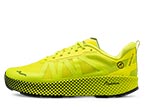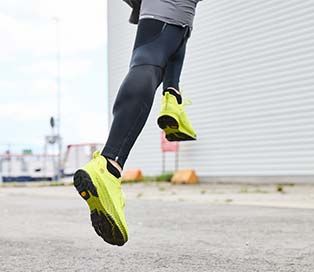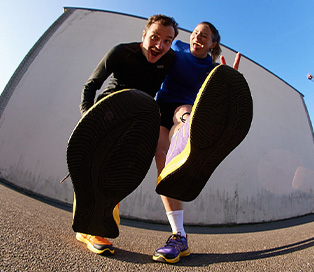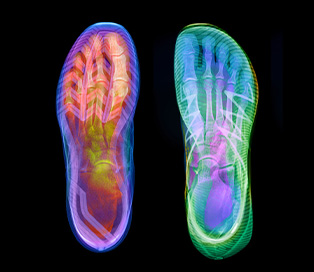Die Wichtigkeit des großen Zehs
„Als ich jung war, stellte ich fest, dass der große Zeh letztendlich immer ein Loch in die Socke macht. Also hörte ich auf, Socken zu tragen.” – Albert Einstein
Die Aufgabe des menschlichen Fußes besteht darin, die Richtung des Gewichtes zu stützen und zu steuern, wenn es sich während der Standphase der Vorwärtsbewegung nach vorne verlagert (Rolian et al., 2009). Grundlegende Leitsätze der Physik weisen darauf hin, dass eine große Auftrittsfläche, die in der Front am breitesten ist, diesen Zweck erfüllt.

- Rolian C, Lieberman DE, Hamill J, Scott JW, Werbel W. Walking, running and the evolution of short toes in humans. Journal of Experimental Biology. 2009; 212:713-21.
- Hoffman P. Conclusions drawn for a comparative study of the feet of barefooted and shoe-wearing peoples. The Journal of Bone and Joint Surgery. 1905; 3:105-36.
- D’Aout K, Pataky TC, De Clercq D, Aerts P. The effects of habitual footwear use: foot shape and function in native barefoot walkers. Footwear Science. 2009; 1(2):81-94.
- Shu Y, Mei Q, Fernandez J, Li Z, Feng N, Gu Y. Foot morphological difference between habitually shod and unshod runners. PLoS ONE. 2015; 10:e0131385.
- Chou S, Cheng HK, Chen J, Ju Y, Wong MA. The role of the great toe in balance performance. Journal of Orthopaedic Research. 2009; 27:549-54.
- Mei Q, Fernandez J, Fu W, Feng N, Gu Y. A comparative biomechanical analysis of habitually unshod and shod runners based on foot morphological difference. Human Movement Science. 2015; 42:38-53.
- Yavuz M, Hetherington VJ, Botek G, Hirschman GB, Bardsley L, Davis BL. Forefoot plantar shear stress distribution in hallux valgus patients. Gait and Posture. 2009; 30(2):257-9.
- Stoneham R, Barry G, Saxby L, Wilkinson M. Relationships between foot structure, function and peak-knee adduction moments in different footwear conditions during over-ground running. Proceedings of the Fortius International Sports Injury Conference, London: September 2018.
- Plank M. The pattern of forefoot pressure distribution in hallux valgus. The Foot. 1995; 5(1):8-14.
- Hashimoto T, Ueno K, Ogawa A, Asamizuya T, Suzuki C, Cheng K et al. Hand before foot? Cortical somatotopy suggests manual dexterity is primitive and evolved independently of bipedalism. Philosophical Transactions of the Royal Society B. 2013; 368(1630):20120417.
- Aiello L, Dean C, Cameron J. An Introduction to Human Evolutionary Anatomy. Elsevier Science; 1990.
- Willems TM, Witvrouw E, Delbaere K, Mahieu N, De Bourdeaudhuij I, De Clercq D. Intrinsic risk factors for inversion ankle sprains in male subjects a prospective study. The American Journal of Sports Medicine. 2005; 33(3):415-23.

















